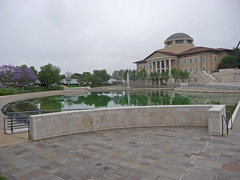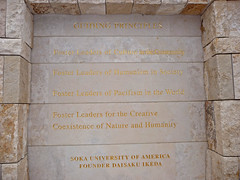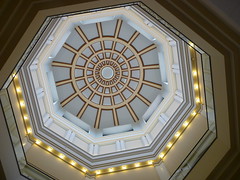 ASPAC was at Soka University of America this year. It’s in the hills above Laguna Beach, just down the road from Irvine, on the edge of a nature reserve. The campus is new — they opened in 2001 — and compact, with shiny new buildings and real ambition. Being a hilltop campus, there’s a lot of stairs; being in southern California, and near a nature preserve, there’s some lovely flora and fauna on campus, and I think I’ve solidified my reputation among my conference colleagues as “the camera guy.” Like so many American colleges, Soka U. has a religious foundation to its community and pedagogy, but is open to non-Soka Gakkai students and faculty1 and has a secular, transformative mission.
ASPAC was at Soka University of America this year. It’s in the hills above Laguna Beach, just down the road from Irvine, on the edge of a nature reserve. The campus is new — they opened in 2001 — and compact, with shiny new buildings and real ambition. Being a hilltop campus, there’s a lot of stairs; being in southern California, and near a nature preserve, there’s some lovely flora and fauna on campus, and I think I’ve solidified my reputation among my conference colleagues as “the camera guy.” Like so many American colleges, Soka U. has a religious foundation to its community and pedagogy, but is open to non-Soka Gakkai students and faculty1 and has a secular, transformative mission.
 Soka Gakkai tends to be something of a sideshow for Japan specialists — a Nichiren sect with a political wing, it’s the largest single religious institution in Japan but usually gets folded in with the rest of the Buddhist traditions; the political aspects of it get subsumed by the LDP’s continuing dominance — but it has a global reputation for peace, environmental and educational projects which goes well beyond their numbers. One of the papers I heard on Sunday was a discussion of the role of foreign language study in Soka Gakkai pedagogy.2 Soka founder Makiguchi Tsunesaburo was an adherent of John Dewey’s liberal humanism and Immanuel Kant’s enlightenment philosophy before he became a Nichiren Buddhist, making it a thoroughly global new religion.3 The engraving on the left reads
Soka Gakkai tends to be something of a sideshow for Japan specialists — a Nichiren sect with a political wing, it’s the largest single religious institution in Japan but usually gets folded in with the rest of the Buddhist traditions; the political aspects of it get subsumed by the LDP’s continuing dominance — but it has a global reputation for peace, environmental and educational projects which goes well beyond their numbers. One of the papers I heard on Sunday was a discussion of the role of foreign language study in Soka Gakkai pedagogy.2 Soka founder Makiguchi Tsunesaburo was an adherent of John Dewey’s liberal humanism and Immanuel Kant’s enlightenment philosophy before he became a Nichiren Buddhist, making it a thoroughly global new religion.3 The engraving on the left reads
GUIDING PRINCIPLES
Foster Leaders of Culture in the Community
Foster Leaders of Humanism in Society
Foster Leaders of Pacifism in the World
Foster Leaders for the Creative Coexistence of Nature and HumanitySOKA UNIVERSITY OF AMERICA
FOUNDER DAISAKU IKEDA
Not only is foreign language required at SUA, but a year of study overseas in a country that speaks the language. Since the student body is just over 400 at the moment, that’s got to make the campus seem even emptier,4 but it makes sense if you’re serious about training global citizens.
 The public centerpiece of the conference is always the banquet, held in the appropriately grand Founders Hall. The featured speaker is almost always the AAS President, who makes the rounds of regional and specialist conferences. Robert Hefner presented some interesting material on religious growth and change in Southeast Asia, including the growth of Pentacostalism and, though he was running out of time, some about the rise of more political Islamic movements. There was a trio of cultural performances — Chinese music, modern Indian dance, and traditional Japanese dance — to cap off the evening. We also got some nice shamisen music — the medly which included the Star Wars theme caught some ears — to accompany our Friday night reception out at the Lotus ponds.
The public centerpiece of the conference is always the banquet, held in the appropriately grand Founders Hall. The featured speaker is almost always the AAS President, who makes the rounds of regional and specialist conferences. Robert Hefner presented some interesting material on religious growth and change in Southeast Asia, including the growth of Pentacostalism and, though he was running out of time, some about the rise of more political Islamic movements. There was a trio of cultural performances — Chinese music, modern Indian dance, and traditional Japanese dance — to cap off the evening. We also got some nice shamisen music — the medly which included the Star Wars theme caught some ears — to accompany our Friday night reception out at the Lotus ponds.
 The private centerpiece of the conference is the board meeting, which was held on Friday night this year after the reception. My board colleagues saw fit to nominate me to another two-year term as secretary, putting my neurotic streak to good use, and that was ratified the next day.5 Though I’m no longer living in the ASPAC region, I do think it’s one of the nicest conferences there is: diverse, lively, nice folks, nice venues. I’ll keep coming: next year’s meeting will be at Portland State University.
The private centerpiece of the conference is the board meeting, which was held on Friday night this year after the reception. My board colleagues saw fit to nominate me to another two-year term as secretary, putting my neurotic streak to good use, and that was ratified the next day.5 Though I’m no longer living in the ASPAC region, I do think it’s one of the nicest conferences there is: diverse, lively, nice folks, nice venues. I’ll keep coming: next year’s meeting will be at Portland State University.
Also, it’s one of the only conferences that takes place in the summer. Why aren’t there more? Is it protectiveness of our summertime? Is it the desire to get away mid-semester? I don’t get it: I hate losing class time to travel, and the paper writing mostly gets done in the summer anyway: the conference is a perfect venue to present a draft, get feedback, then go back and revise, submit.
Anyway, I’ve got a few panels and papers I want to talk about, and I’ll do that over the next few days. Most of the papers I want to comment on were about Japan, which is kind of unusual, actually. There were a couple of China papers, though, so check in over there sometime soon.
I can’t speak for the student body, but the Soka faculty who’ve dealt with the ASPAC board aren’t SG adherents ↩
The paper was arguing that Soka theory leads to a more advanced and effective language teaching system, but most of it sounded an awful lot like the dialogues, N+1 and immersion methods I encountered in the ’80s. The Makiguchi stuff was fascinating, though. ↩
No, I’m still not sure how you combine Kant, Dewey and Nichiren in a consistent theological fashion. The tensions between nationalism and internationalism, enlightenment ecumenicism and Lotus Sutra exclusivism, just to name a few, seem substantial. My personal experience with SG members in Japan suggests that it propogates as a sort of Prosperity Gospel, but that doesn’t actually simplify anything. ↩
There were about a hundred people at the conference, plus a couple of dozen people participating in other unrelated groups, and there was clearly capacity for lots more. ↩
mostly by the board, since hardly anyone else shows up to the general business meeting ↩
Thank you for the report. I’m a graduate student and have been weighing the potential of specializing somewhat in Komeito as a research subject. Of course Komeito and Soka Gakkai are inseparable – even SGI comes into play a bit. I’m very interested to hear what papers were presented, and especially whether the likes of Daniel Metreaux and James Dator were present.
Neither name rings a bell, and this linguistics paper was the only one that I heard all weekend that directly addressed Soka Gakkai. ASPAC is general Asian studies conference, so there’s rarely a strong theme to the papers, though sometimes people organize “streams” — multiple panels on related topics — which can be quite fun.
Still, Komeito and the role of SG/SGI in public life would be a perfectly good topic for further research, in my view.